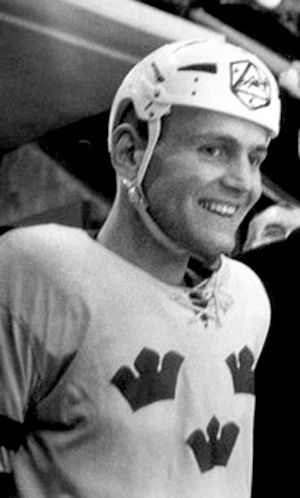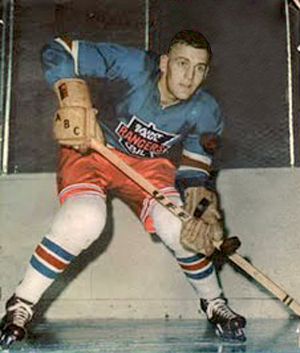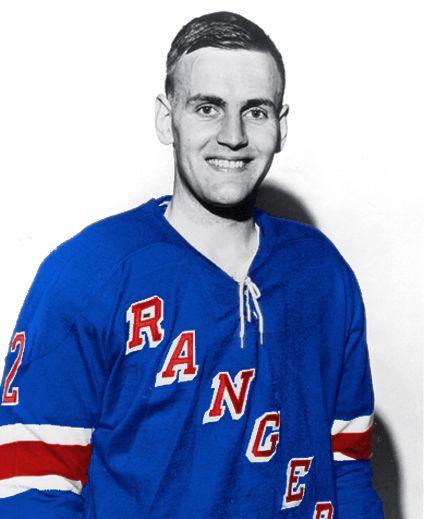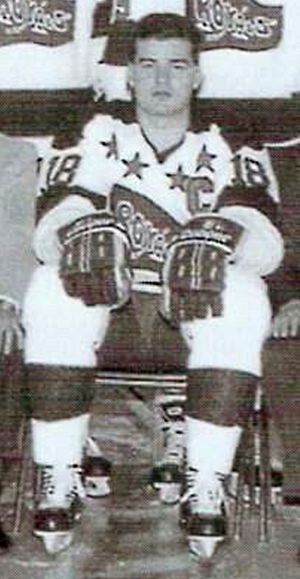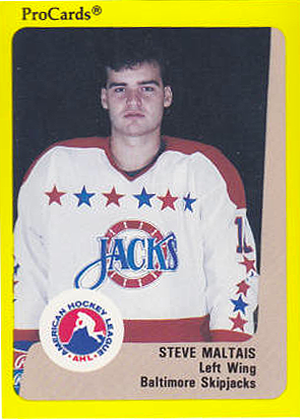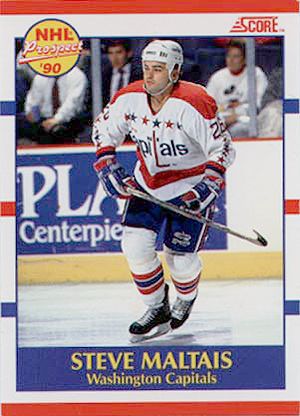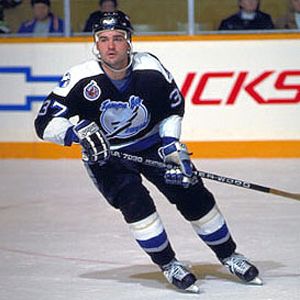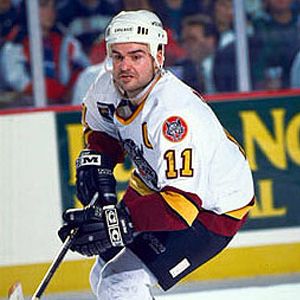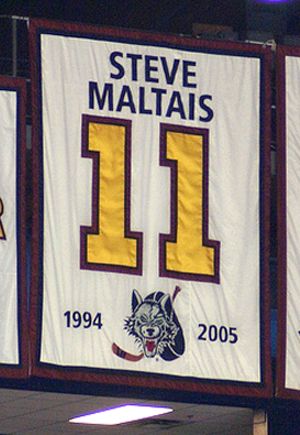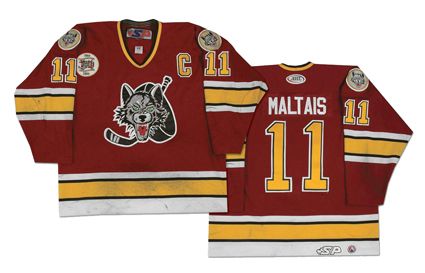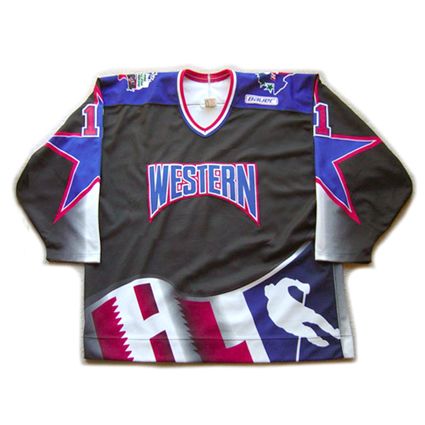Proving once again that not every successful career in hockey revolves around time spent in the NHL, Steve Maltais,
born in this date in 1969, began his career in hockey with the Cornwall
Royals of the Ontario Hockey League in 1986-87. Showing his offensive
talent right off the bat, the 17-year-old scored 32 goals as a rookie in
junior hockey.
Following the season he was drafted by the Washington
Capitals 57th overall in the 1987 NHL Entry Draft. Still with the
Royals, he raised his goal total to 39 the following season, and
combined with his 46 assists, registered 85 points in 59 games.
Cornwall Royal Maltais
His
final season with Cornwall saw another quantum leap forward for
Maltais, as he led the Royals in scoring with 53 goals and 70 assists
for a 123 point campaign, good for fourth overall in OHL scoring. He
then led the club in playoff scoring with a dominant 14 goals and 16
assists for 30 points in 18 games. Following the conclusion of the
Royals season, Maltais began is professional career with 4 playoff games
with the Fort Wayne Komets of the International Hockey League.
For
the 1989-90 season, he was assigned to the Baltimore Skipjacks of the
American Hockey League, where the AHL rookie was third in team scoring
with 66 points in 67 games as well as 16 more in 12 playoff games.
During the season he also made his NHL debut with the Capitals,
appearing in 8 regular season games and 1 playoff game, yet failing to
register a point.
Back
with Baltimore for the 1990-91 season, he proved he had not forgotten
how to score, 36 goals and 79 points came in 73 games, yet when called
up by the Capitals for 7 games, he once again was snake-bit, failing to
score even a point once again.
During
the offseason, his rights were dealt to the Minnesota North Stars and
as a result he spent 48 games with the North Stars IHL affiliate, the
Kalamazoo Wings, where in 48 games he scored 25 goals and 56 assists. He
was also called up to play with Minnesota in the NHL, where the
thankfully scored not only his first NHL point, but goals as well with a
pair of goals and an assist in 12 games. However, he was traded in
early March of 1992 to the Quebec Nordiques organization, who assigned
him to the Halifax Citadels in the AHL for 10 games to finish out the
season.
During the offseason his
rights were claimed by the expansion Tampa Bay Lightning, with whom he
played 63 games, more than half his eventual NHL total, scoring 20
points. He exceeded that mark with 24 points in 16 games with the
Atlanta Knights of the IHL that same season.
On
the move once again, Maltais was then traded by Tampa Bay to the
Detroit Red Wings for the 1993-94 season. Detroit called him up for 4
games that season, but the vast majority of his time was spent playing
for the Adirondack Red Wings in the AHL, netting 35 goals and 84 points
in 73 games. He also led the club in playoff scoring with 16 points in
12 games.
Now without a contract,
his life and career changed in September of 1994 when he signed a free
agent contract with the brand-new Chicago Wolves to be their team
captain for their first season of play in the IHL. He immediately led
the team (and all of Chicago for that matter) in scoring with 57 goals
and 41 assists for 98 points as well as a 145 penalty minutes, his first
career season over 100 penalty minutes. His 57 goals also led the IHL
in that category for the season.
Back
with the Wolves for the 1995-96 season, he nearly equaled his goal
total with 56, but raised his assist total to 66, giving him a career
high 122 points, which only placed him second on the club! He also found
the time to spend 161 minutes in the penalty box.
Maltais
next set a career high with 60 goals in 1996-97 during a 114 point
season, reclaiming the IHL goal scoring title in the process. The
following season he reached 46 goals and 103 points, to lead the Wolves
in scoring for the second time in their four years to date. His 46 goals
also tied him for the league lead in that category. The Wolves then
went onto the postseason, defeating the Manitoba Moose in 3 straight,
ousting the Milwaukee Admirals and then the Long Beach Ice Dogs in 6
games each to advance to the finals against the Detroit Vipers in what
would turn out to be a hard fought 7 game series, where the Wolves came
back from a 3-2 to win Games 6 and 7 to earn their first
Turner Cup championship.
Maltais'
fourth consecutive 100 point season came in 1998-99 as part of a 56
goal performance, his fourth season of 55 goals or more in his five
seasons with the Wolves. His 56 goals were 10 more than his next closest
pursuer, and his fourth time leading the league.
He
once again repeated as the leading goal scorer in the IHL, with 44 in
1999-00 on his way to a 90 point season, ending his 100 point streak at
four, but oddly, despite seeing his streak of 100 point seasons ending
and putting up his lowest point total in six seasons, Maltais actually
led the entire IHL in scoring for the only time, earning the
Lamoureux Trophy in the process!
During
the playoffs, Maltais was second in team scoring with 13 points in 16
games as Chicago swept Long Beach in 4, outlasted Houston in 5 and
defeated Grand Rapids 4 games to 2 to won their second Turner Cup.
2000-01
was a season of change, and with the NHL expanding yet again, the
upstart Columbus Blue Jackets came calling, signing Maltais as a free
agent for their inaugural 2000-01 season, but in 26 games, his NHL
scoring jinx was still in effect and he was released after registering
just 3 assists and no goals.
Change
was also the order of the day in the minors, as the IHL had ceased
operations at the end of the previous season, but the Chicago Wolves
were one of six teams admitted to the AHL, and Maltais returned home to
the Wolves, scoring 31 goals and 63 points in 67 games. Chicago again
went on a postseason run, defeating the Cincinnati Mighty Ducks 2 games
to 1 in a close fought three game series, with each game ending with the
same 3-2 score, one in overtime. They then won Game 5 of a five game
series on the road against Grand Rapids before winning Game 7 of a seven
game series on the road against Syracuse. Fellow IHL refugees the
Houston Aeros fell in five games after Houston had won Game 1 followed
by four straight by the Wolves. Chicago then split the opening two games
on the road before returning home to win three straight to defeat the
Bridgeport Sound Tigers 4 games to 1 to capture the
Calder Cup in their first season as members of the AHL despite entering the playoffs with the 16th best record in the league!
The 2002-03 season saw another 30 goals and 86 points, which earned him the
Sollenberger Trophy
as the AHL's leading scorer. That was followed by 31 goals and 64
points in 2003-04 to lead the Wolves in scoring for the sixth time in
the Wolves ten seasons.
In his
final season, Maltais scored 60 points in 80 games, plust 12 more in 18
games as the Wolves made it all the way to the Calder Cup finals to
close out his career. In his 11 seasons as a member of the Wolves,
captaining the team for nine of them, the club never had a losing
record.
While is NHL career
totals are an unremarkable 9 goals and 27 points in 120 games, his
combined IHL and AHL totals are an impressive 596 goals and 669 assists
for 1,265 points in 1,126 games, two scoring championships (one in each
league) as well as two Turner Cups and a Calder Cup championship. He
still holds the record as the franchise's all-time leading scorer and
his 596 goals ranks 8th in minor league history. His #11 was retired by
the Wolves on April 15, 2006, one of only two numbers ever retired by
the club.
Today's featured jersey is a 2003-04 Chicago Wolves Steve Maltais jersey.
The Wolves wore this style for every one of their seasons in the IHL
with only minor patching variations to report, including the IHL 50th
Anniversary patch during their inaugural 1994-95 season, Turner Cup
Finals patches in 1998, 2000 and 2001, as well as several sponsor
patches throughout their history. Today's featured jersey is decorated
with the Wolves 10th Anniversary patch.
While the top minor league affiliate of the Atlanta Thrashers, the Wolves did adopt a
striking alternate jersey
heavily influenced by the Thrashers original template, only with enough
unique additions, especially on the torso of the jersey to make it
their own.
Even with the change
to the new Reebok template and it's curved lower hem, the Wolves have
remained true to their original home and away jerseys, worn now for 18
seasons.
Bonus Jersey: Today's bonus jersey is a 1995-96 IHL All-Star Game Steve Maltais jersey.
Eerily similar to the "waving flag" style Nike jerseys used in the 1996
World Cup of hockey, this IHL All-Star jersey frankly isn't the most
attractive jersey we've ever seen, but it does speak to the unquestioned
success Maltais had in the IHL and later the AHL, with his multiple
championships, scoring titles and all-star game appearances.
In today's video section, take a look at the goal scoring prowess of Maltais.
